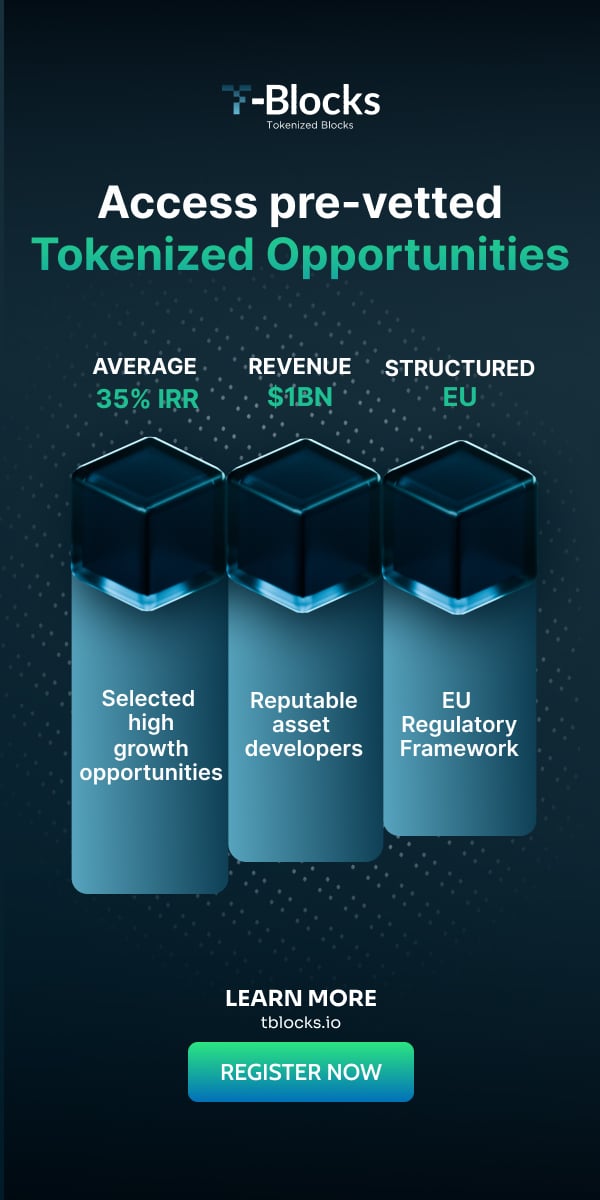How to avoid disaster in the tokenization of financial assets
Blockchain-based financial applications are considered to be the future of the financial system. From banking the unbanked to lowering fees and allowing for personalised, consumption-based insurance, blockchain-based applications are intended to renew legacy systems and replace many intermediaries. However, this requires further thinking than ever before.
By Ralf Kubli, Board Member, Casper Association
The key to the transformation of financial systems lies in tokenising all assets, including cars, paintings, videos, blueprints and digital art. Tokenization will facilitate easier trading and securitisation of these assets. While the boom around Non-Fungible Tokens (NFTs) proves that there is a market for native digital art in the form of tokens, the tokenization of financial instruments is still in its infancy.
Thanks to the algorithmic nature of financial contracts, the financial industry is in the best possible position to benefit from blockchain technology. This is why accelerating the adoption of tokenization in finance must be a priority. The benefits derive from how blockchain and distributed ledger technology (DLT) work. These include instant settlement – also pointedly described as “the trade is the settlement” – optionally programmable transparency or confidentiality, automation of processes and verifiability.
While there are exciting initiatives in these areas, the infrastructure for blockchain-based money and capital market transactions is still in its early stages. Secondary markets for tokenized financial instruments are just emerging, and there is still little momentum developing in the primary issuance market. With the Distributed Ledger Technology (DLT) Act, Switzerland has laid the foundation for a global leadership role in the future blockchain-based capital market.
Although the legal requirements have now been met with the legal register value in Switzerland for the tokenization of financial assets, the technical and content-related implementation at the core falls far short of the mark. In fact, there is a risk that the new infrastructure will result in an even more chaotic and fragile system than we have in place today. Unless this fundamental issue with the current security tokens is addressed, we are heading for disaster. Let’s examine the reasons and solutions that can prevent a potential catastrophe.
Insufficient machine readability produces dumb tokens
Most security tokens that represent financial assets are very limited in functionality; some would even say that they are “dumb tokens”. Issuers and trading venues mostly focus on technical questions about the token itself: “How can the token be traded? How and where is it kept? Who has access to the register in which ownership is recorded, when and how? What about delivery vs payment? What denominations are allowed?”
Without a doubt, these are all important questions for the functionality of the new infrastructure. However, these tokens usually say nothing or very little about the nature and properties of the actual financial value that is exchanged on these trading venues. To fully realise the potential of the new DLT-based capital markets, security tokens must have a technical implementation that goes beyond simply being a DLT register that points to a term sheet PDF.
The following three scenarios show what the situation looks like today, the confusion that results from the individual programmability of tokens and what the future should look like with smart financial contracts on blockchains.
The current reality in the world of security tokens
Let’s take a bond that is offered as a security token on a trading platform as an example. Thanks to the properties of the blockchain, a buyer can now buy a token with T+0, in other words, immediately. However, how the future cash flows of this bond are defined and what valuation results from them must be compiled by analysts in detail from the written term sheets and then calculated, mostly in excel.
The calculation and reconstruction of future cash flows to determine a financial value under certain assumptions is a common practice in mature and existing markets. Companies like Telekurs, Bloomberg, and Refinitiv already supply this information for a fee to reduce the buyers’ workload.
The future will be more complex than the present
As a second example, let’s assume that an issuer of security tokens – in addition to technical aspects such as custody, trading, and denomination – has also given a description of the cash flows in digital form. This would require numerous attributes such as day count method, interest calculation, terminal value calculation, cap and floor to be defined and linked consistently with the cash flow generating algorithms.
It is doubtful that inexperienced blockchain programmers can consistently map all aspects of a financial instrument in this scenario. Even if a comprehensive description were provided, there is a risk that each tokenization platform, each issuer or programmer, will design the description of the cash flows (e.g. the terms of a bond) based on their own definitions. In that case, each security token would be like a small core banking system with its own definitions and calculation methods. The result would be thousands or millions of differently defined bonds listed on DLT-based trading systems, impossible to understand for the professional user.
Such complexity is not manageable for man or machine with reasonable effort. And in such a world, the Big Four among the accounting firms would have to be hired again as assurance service providers as new questions would emerge, such as “Is bond XYZ consistently programmed? How are cash flows calculated? What terminal payment amount is due when?”. Likewise, the long-serving and new information suppliers would have to step in as translators of term sheets.
In such a scenario, security tokens would only be comparable with great effort and would not be interoperable. It would be unrealistic to expect the securitisation of portfolios from different issuers to cost less than in today’s complex legacy world. This would result in a lack of liquidity on DLT-based trading venues. What does this achieve? We would have a bad and more chaotic copy of the current system in our hands. The adoption of the new infrastructure financed by investors would be called into question because why should financial market players switch to these new systems if no lower costs and no higher degree of automation can be achieved?
Unfortunately, there is no prospect of a substantial automation and complexity reduction of the financial instruments traded on the currently planned and existing DLT systems. This is not due to the technology providers but rather the financial players who have not yet discovered the core of their task: the exchange of value calculated from cash flows over time through a financial contract. The return to this fundamental component of finance must also be the basis for innovation in the new DLT and blockchain-based world.
The smart financial contract on the blockchain
The term smart contract is used imprecisely in the blockchain world. Anything programmed on a blockchain is called a smart contract. Vitalik Buterin himself, one of the co-founders of Ethereum, regretted introducing this term in 2018. A programming language is a necessary but not sufficient condition to define smart contracts. In order for a piece of software, like a token, to actually become a smart contract, programmability alone is not enough. In addition, Nick Szabo’s terms and conditions for smart contacts must be observed. One can speak of a smart contract when the following four conditions are met: observability, verifiability, privacy and enforceability.
The efficiency of the new infrastructure results from the observability on the blockchain and the verifiability of the contractual agreements on the basis of a standardised, well-defined, published, programmed and independently verifiable financial smart contract.
Applied specifically to a bond, this means that past payments must be verifiable. Likewise, the expected cash flows in the future, like when an interest payment from one party to another is due, must be machine-readable and machine-executable in the smart contract. Otherwise, a review of the terms of the contract cannot take place automatically. The verifiability of the cash flows is achieved through the properties of blockchains and the implementation of the open-source ACTUS standard, which defines the cash flows. Based on these cash flows, all relevant financial information can be derived, such as financial values under different valuation methods, income, sensitivity and risk.
The intelligent security token
In addition to the misconception that the programmability of a token is sufficient to generate a smart contract, the term “tokenization of assets” also causes confusion. What exactly is tokenized? For example, a CryptoPunk is a native digital artwork that one owns through the token. For a bottle of wine offered on a marketplace, possession of the token controls a defined ownership right. For investments such as real estate, the token often represents shares in a special-purpose special vehicle. But in all of these cases, only the asset side is shown.
In the case of financial contracts, which are represented by an intelligent security token, it is about the agreement of counterparties to exchange cash flows over time. In finance, therefore, the presentation of the liabilities and assets side is mandatory. For DLT and blockchain-based systems to really deliver on the promise of innovation in finance, at least three requirements must be met:
1) Information about which party holds the liability
2) The information about which party holds the asset side
3) A definition and algorithmic description (i.e. mathematical representation) of the contractual arrangements from which the future payments are derived (e.g. through the ACTUS standard).
The key to the success of the new DLT-based infrastructure of the capital markets lies in the complete readability and executability of these contracts by machines. Combined with the properties of blockchains, there is always clarity as to which parties are obligated to make payments and which parties have the right to receive the payments. Thanks to the algorithmic definition of the cash flows by the ACTUS standard, the value of the financial instrument can be determined in near-real time, taking into account external risk factors such as market risks, counterparty risks, and behavioural risks.
The promise of automation reducing complexity and costs, especially in trading and in the securitisation of DLT and blockchain-based financial instruments, can only be fulfilled with smart financial contracts that have these properties.
Conclusion
With the focus of blockchain applications on payments and the confusion arising from the tokenization of assets, there is a risk that the emerging blockchain-based infrastructure of capital markets will degenerate into a poor copy of today’s financial system.
Instant settlement and transparent ownership of tokenised financial instruments on DLT platforms alone will not be sufficient for the widespread adoption of this new technology.
Smart financial contracts, which verify the current state of payments, future cash flows and the ownership of the asset and liability side for machines to process and execute, are the decisive prerequisite for achieving the expected advances through the blockchain in finance.
Notes and further reading
This formulation comes from Guido Bühler, CEO of Seba Bank AG, who describes the blockchain-driven transformation in the finance sector with the following aspects: 1) Blockchain is the most efficient transfer of ownership 2) The trade is the settlement 3) The private key is the perfect collateral, and 4) tokenization is origination.
Nick Szabo on Smart Contracts, 1996: http://www.alamut.com/subj/economics/nick_szabo/smartContracts.html
A smart contract exists when the following four conditions are met: observability, verifiability, privacy, and enforceability.
1) Observability, the ability of the principals to observe each other’s performance of the contract or to prove their performance to another principal
2) Verifiability, the ability of a principal to prove to an arbitrator that a contract has been performed or breached, or the ability of the arbitrator to find this out by other means
3) Privity, the principle that knowledge and control over the contents and performance of a contract should be distributed among parties only as much as is necessary for the performance of that contract
4) Enforceability, and at the same time, minimizing the need for enforcement. Improved verifiability often also helps meet this fourth objective
On the subject of Actus and Smart Contracts: Dr Willi Brammertz, presentation at the UZH Blockchain Center of the University of Zurich: https://www.blockchain.uzh.ch/events/industry-talk-actussmart-financial-contracts-the-future-of-capital-markets/
Open source algorithmic financial contracts: www.actusfrf.org
On the topic of DLT law: developments in Swiss blockchain law. Edited by Rolf H. Weber, Hans Kuhn, 2020. https://www.helbing.ch/de/detail/ISBN-9783719044251/Entwicklungen-im-Schweizer-Blockchain-Recht
On the subject of delivery vs payment and settlement – Jura project: https://www.bis.org/about/bisih/topics/cbdc/jura.htm
Introduction to tokenization: the University of Basel Center for Innovative Finance. Prof. Dr Fabian Schär https://www.youtube.com/watch?v=kcpZd3QqS4Q&list=PLoVRRjQbqYFyV6DQtoNlCbnp3QrvSITPi&index=15
Federal Council report: Federal Council, Legal basis for distributed ledger technology and blockchain in Switzerland. An overview with a focus on the financial sector (Bern, December 14, 2018). «DLT report» https://www.admin.ch/gov/de/start/dokumentation/medienmitteilungen.msg-id-73398.html
Read other stories: Hamilton Lane’s $2.1 Billion Flagship Direct Equity Fund Now Available for Investment on Securitize
Oxbridge Re announces new subsidiary ,SurancePlus, to issue tokenized reinsurance securities






















